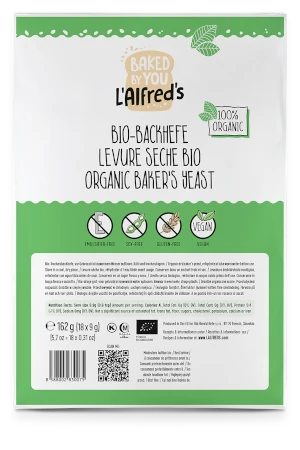

Tasty yeast creations become a valuable source of nutrients with L’Alfred’s vitamin D yeast. Because just 100g of baked goods baked with the special L’Alfred’s vitamin D yeast cover at least 15% of the recommended daily requirement of vitamin D. In bread dough, in puff pastry as well as in sweet dough: L’Alfred’s dry yeast with vitamin D can be used as usual in baking, because it has the same baking properties as ordinary yeast. The yeast powder in professional baker’s quality ensures a light and airy dough and supports your body in many vital processes thanks to the extra portion of vitamin D. Get the sun on your plate!
The vacuum-sealed packaging protects the yeast powder from moisture penetration and keeps it for months. The gentle drying process interrupts the ripening process of the yeast so that it can be easily stored in the household.
After opening, unused dry baker’s yeast should be stored in a cool, dry place. Tip: The easiest way to store unused yeast is in a sealed container in the freezer.
The dry yeast does not need to be dissolved in water beforehand and is therefore extra easy to process and dose.
1.Simply take the desired amount of yeast powder from the packaging and mix it directly with the dry ingredients.
2.Then add the wet ingredients.
3.Once the dough has risen as usual, depending on the recipe, you can continue to process it.
Baking with L’Alfred’s is so easy!
Always store leftover L’Alfred’s dry yeast in a dry and cool place. 9 grams are sufficient for 500 g of flour.
Our vitamin-rich yeast is irradiated with UV light during fermentation. Similar to how our skin produces vitamin D when exposed to sunlight, yeast can do the same while exposed to UV light. The vitamin D produced by the yeast bacteria themselves stores in the yeast cells until the yeast is enriched with 200 µg of natural vitamin D (calculated per 100g of dry yeast). This process ensures that we can do without chemical or synthetic vitamin D additives during production. The self-produced vitamin, which is stored in the yeast cell, can thus also survive the baking process undamaged.
Another plus of our vitamin-rich baker’s yeast: it is naturally vegan, as well as soy- and gluten-free.
The individual dosage depends on the recipe and in the end determines the vitamin D content in the baked goods. If you want to know exactly how much vitamin D is in your recipe, feel free to ask us.
Of course, our body is able to produce vitamin D itself when sunlight hits our skin. However, weak sunlight in winter or covering our skin with clothing or sunscreen reduces vitamin D production. Without it, we lack a primary source of supply of the vitamin, which is important for healthy bones and a functional immune system, among other things.
To improve vitamin D supply, yeast enriched with vitamin D has been known since the 1940s – because an adequate supply of the body provides the optimal basis for your well-being. A valuable contribution to your health!
Clean Eating
Functional Food
Vegan
Vegetarian
Halal
Kosher
Gluten Free
Soya free


This simple recipe for homemade rolls made from a rye-spelt-wheat flour mix is ideal for baking beginners. With just a few ingredients and handles, the dough is quickly made the night before and can then rest in the fridge overnight for 12-13 hours.
The next morning, the dough is carefully removed from the bowl and simply divided into 8 roughly equal parts without further kneading or complicated shaping of dough pieces. Depending on the shape of the bowl, this creates round or square bun shapes. And even if the rolls look very small at first, they still rise in the oven.
The wheat and spelt flours keep the rolls fluffy on the inside, while the rye flour provides a strong aroma and a firm crust. This mix is ideal when you don’t have much time to bake. If you would like some additional variety, you can brush the rolls with a little water before baking and then roll them in seeds, grains or oat flakes.
This way you quickly have a whole tray full of different rolls and the breakfast table looks more varied!
Combine all ingredients in a bowl and knead well. L’Alfred’s dry yeast can be mixed directly into the flour without dissolving in water.
Leave the dough to rise in a covered tin or bowl in the fridge for 12-13 hours.
The next morning, remove the dough from the container and place on a floured work surface. Now carefully divide the dough into 8 roughly equal pieces without kneading first. The individual loaves will look relatively flat, but will still rise in the oven.
Put a bowl of water in the oven and preheat it to 250° C convection oven.
Bake the tray with the loaves for 10-12 minutes in a warm oven.
Tip: If you like it a little more grainy, add some grains to the dough before baking. Sunflower seeds, pumpkin seeds or linseeds are suitable for this. To ensure that the grains stick well to the roll, it is advisable to brush the dough piece with water, milk or egg yolk beforehand.
Want even more quality? This recipe also works great with our organic yeast.
